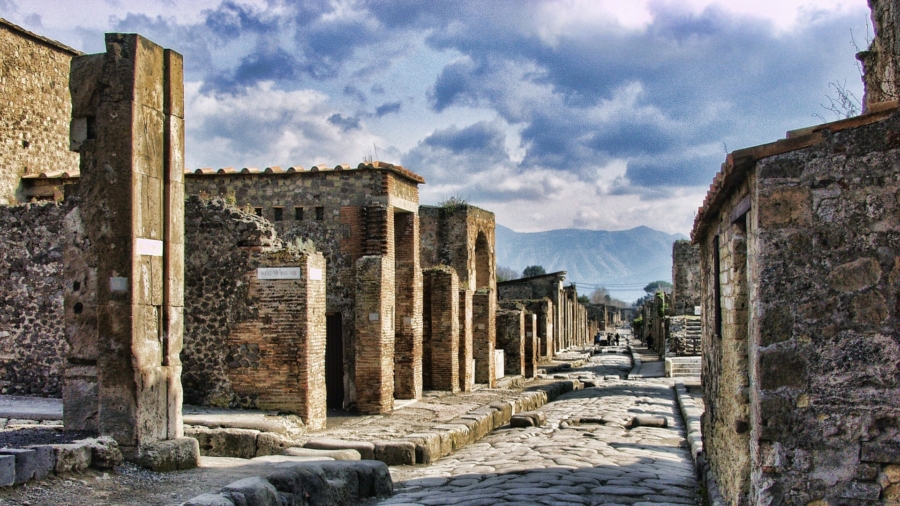Archaeologists believe that several bombs that were dropped during WWII have landed near the ruins of Pompeii, and warn that at least 10 of them have not yet exploded, according to multiple reports.
Il Fatto Quotidiano, a local Italian newspaper, reported that back in August 1943, Allied forces dropped a total of 165 bombs in the area over a span of nine air raids, and at least 10 of them have yet to explode. The Italian news outlet reported that these bombs were hidden in the foundations of the ruins, according to the Irish Times.
Archaeologists have located and deactivated 96 bombs so far. However, some haven’t been discovered yet and may have either defused or already exploded.
“The other bombs ended up in an area of the site that has not yet been excavated. Many of them were defused or had already exploded. But at least 10 of those explosives are still there,” the Italian newspaper wrote. The Irish Times reported that it was the first time that the Italian paper had published documents that were exclusively from the national aerial photographic archives, which included a bombing map, along with interviews with various archaeologists and experts.
According to Ars Technica, there were reports of German soldiers hiding in the ruins of Pompeii back in November 1943. Times of London reported at the time that since Germans had encamped at the site of the ruins, the “Allied aircraft were obliged to treat it as a military objective.” They also received reports that German soldiers had set up camp and a command post within Pompeii’s ruins, complete with anti-aircraft guns.
However, in 1944, Archaeological Superintendent Amedeo Maiuri wrote that while the command post was real, the division of encamped German soldiers was a rumor. In reality, the Nazis only had two anti-aircraft guns with a few trucks parked nearby—both of which were well outside Pompeii’s city walls.
Il Fatto Quotidiano was made aware of the existence of these unexploded bombs from Antonio De Simone, an archaeologist and professor at the Suor Orsola Venincas University of Napels, who said, “In 1986, I came across unexploded bombs in Pompeii during some excavations.”
“We were there with our chisels and shovels, slowly lifting a handful of earth at a time and suddenly we found the bombs, under our feet,” Simone said. “There were two of them. One had already exploded and was reduced to fragments. The other, unfortunately, had not. It was perfectly intact.”
Fox News reported that around 108 acres of the ruins of Pompeii have been checked for bombs, but some 54 acres still remained undisturbed and unsearched, according to researchers. Despite that, the Archaeological Museum of Pompeii said that the bombs pose no risk to visitors.
“There is no risk for visitors. The site has regularly drawn up the reclamation project, which is carried out by the military. Area reclamation was carried out per meter,” the museum wrote.
While it is possible to unearth all of them, it is both a time-consuming and expensive effort. However, leaving the unexploded bombs in the ground wasn’t exactly ideal, as it poses a great deal of danger to archaeologists and researchers alike who might inadvertently dig them up and cause damage to both themselves and the very ruins they are trying to preserve.
Archaeologists have been studying the ruins of Pompeii since their discovery in the 16th century, according to Fox News. Researchers have been excavating the ruins in hopes of understanding the people and the culture before disaster struck in 79 AD. Almost overnight, Mount Vesuvius erupted and covered the entire city in ash, effectively wiping out Pompeii and its inhabitants. Fox News reported that when the volcano erupted, the following debris, lava, and explosions overwhelmed the city and created so much heat that people’s skulls exploded. At the time, the violent heat caused their blood to boil.
Although the exact date of the disaster is unknown, researchers have been quarreling among themselves in speculation of the exact month that the disaster took place—some say it was August of that year and others say October, according to Fox News. Archaeologists have unearthed some surprises including a thermopolium—an ancient type of eatery where the inhabitants of Pompeii were able to get hot food. Researchers also discovered several frescoes and murals along with the petrified body of a horse.

